Realme 5 Pro vs Mi A3: In-Depth Comparison: 48MP Triple Camera vs 48MP Quad Camera, Who Got It Right?

Xiaomi and Realme are again set to take on each other this week. The company will be launching the third generation Mi A3 in the country on August 21, and Realme unveiled the Realme 5 series today. Mi A3 will directly take on the upcoming Realme 5 smartphone with a similar set of specs, while the pricing is in line with the Realme 5 Pro.
So, should you be buying the new Mi A3, or go for the new Realme 5 or Realme 5 Pro a quad camera system?
Mi A3 has its own set of positives and negatives, while Realme 5 series has a lot of good to be discussed. The Android One interface definitely makes a big difference, while the only-HD+ display could be a deal breaker for many. The smartphone comes with a complete glass body, a new processor, larger battery and triple camera system.
Here’s an in-depth comparison between Realme 5 Pro and Mi A3.
Contents [hide]
Build Quality: Glass Body With 3D Back Glass vs Polycarbonate
On Mi A3 you will get a complete glass body covered by Corning Gorilla Glass 5, 3D rated. Unlike the current Redmi glass body smartphones, the Mi A3 feels very premium and the 3D glass curves make it easy to hold all throughout including the curves. The compact screen size makes it perfect to be used with a single hand, and the higher screen to body ratio makes sure you can consume content without any issues.
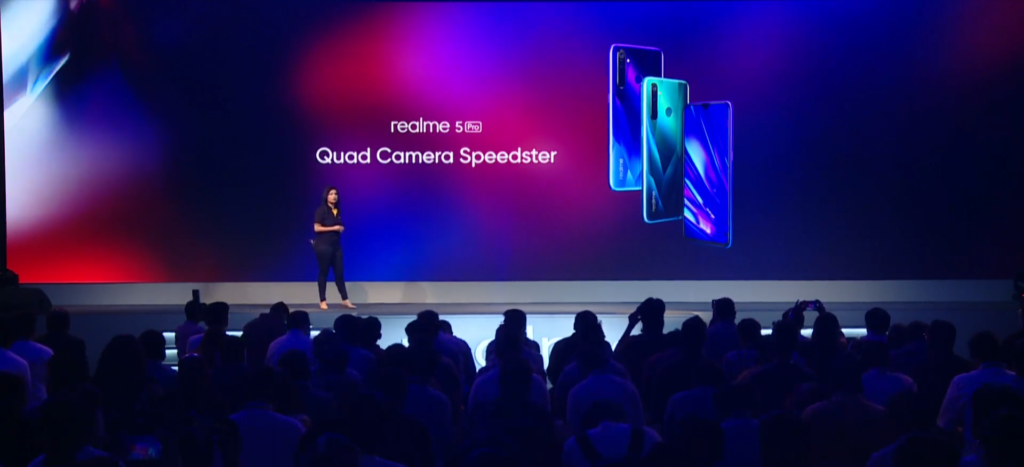
Coming to design, the smartphone features an all new colour combinations on the out with gradient finish. The rim between the glass is made up of plastic, but that doesn’t make much of a difference.
The Realme 5 Pro comes with a high-quality polycarbonate body. It’s plastic, but does feel premium. The high quality polycarbonate built is backed by some of the striking gradient colour schemes. There’s a rear mounted fingerprint sensor. The colour mixes are stylish, but a glass body would have been better.
Realme 5 Pro has been launched in two colour options: Crystal Green and Crystal Blue.
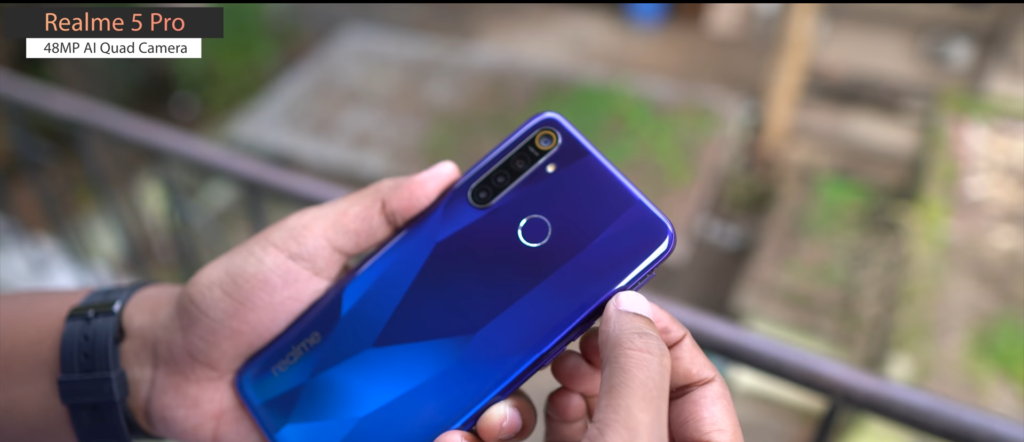
The company has used a new design this time called ‘Crystal design’ with 3D curved glossy plastic rear panels. The diamond-cut design is back, and this time with a new triangular pattern. A slight upgrade over the older Realme devices, the new Realme 5 smartphones are a bit different.
There’s a new plus, the Realme 5 smartphones also come with splash-resistant designs.
Anyway, plastic is plastic, and glass is glass. The Mi phone has a glass body, so can’t complain. In terms of looks and build quality, Realme 5 Pro does an average job here. In all, it’s good and feels good to be used. The overall ergonomics are perfect, while the new 3D built curves make it really easy to hold.
In-Display Fingerprint Sensor vs Physical Fingerprint Sensor
While leaving the argument apart whether the physical fingerprint sensor does a better job or the in-display fingerprint sensor is necessary or not, Mi A3 comes with an in-display fingerprint sensor under the screen glass. It’s a premium feature, leaving the convenience part apart.
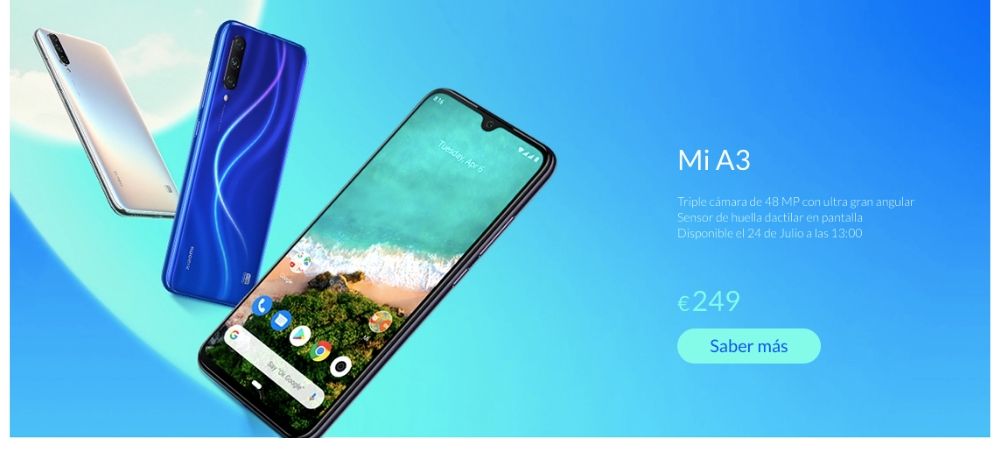
It’s going to be Xioami’s only budget smartphone in the country to feature an in-display fingerprint sensor.
It’s quite fast, and with the AMOLED panel, you have to option to have an always-on screen, so that you can unlock your smartphone without tapping.
While Realme 5 Pro will come with the same rear-mounted fingerprint sensor as it’s predecessor. For many, the physical fingerprint sensor is still a better choice. Leaving this feature comparison to you, whichever you like, it’s a winner for you at the budget. Both the smartphones won’t disappoint you.
Full HD+ LCD vs HD+ AMOLED Display: What To Choose?
This could be a big deal breaker for many, but honestly, it’s really hard to notice the difference. The company surisplingly used a HD+ only display for Mi A3, but it’s an AMOLED panel. If you look really really close, you may see the difference between a Full HD IPS LCD panel, but for day to day use, that doesn’t make much of a difference.
The screen size does offer a higher screen to body ratio with a thin chin down under.
It’s a circular notched display in an 19.5:9 aspect ratio measuring 6.08-inch. The HD+ AMOLED offers 530 nits of brightness. The broad daylight visibility is more than okay and viewing angles are absolutely fine. Realme 5 Pro has has been rumoured to feature a 6.5-inch Full HD+ water drop notched display.
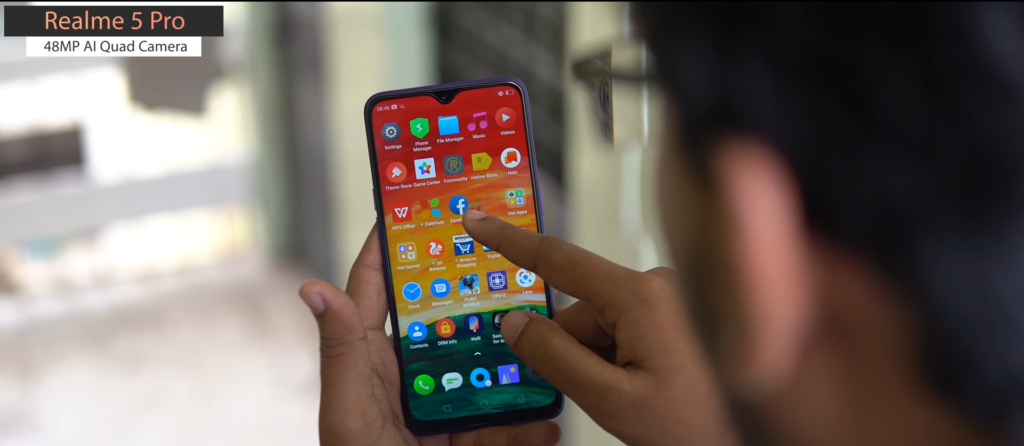
Realme 5 Pro features a 6.3-inch Full HD+ Mini-Drop display with 450 nits brightness and Gorilla Glass 3 protection. It offers a screen-to-body ratio of 90.77 percent with a screen resolution of 2340 x 1080 pixels with a new smaller-sized V-shaped notch to offer a full-screen display.
Hardware & Performance: Can Snapdragon 665 Take It?
Mi A3 will come with the new Qualcomm Snapdragon 665. The chip stands between Snapdragon 660 and Snapdragon 675. While it does have a bit more to offer than its predecessor, the new chip comes with added artificial intelligence capabilities.
With Android One to take up the power, the Snapdragon 665 offers some great performance in terms of mid-end games and extensive multitasking.
But here Realme has better to offer. The Pro model will come with a Qualcomm 700 series chip. The toned-down Realme 5, on the other hand, will be powered by the same chip as Mi A3. Realme 5 Pro will be powered by Qualcomm Snapdragon 712.
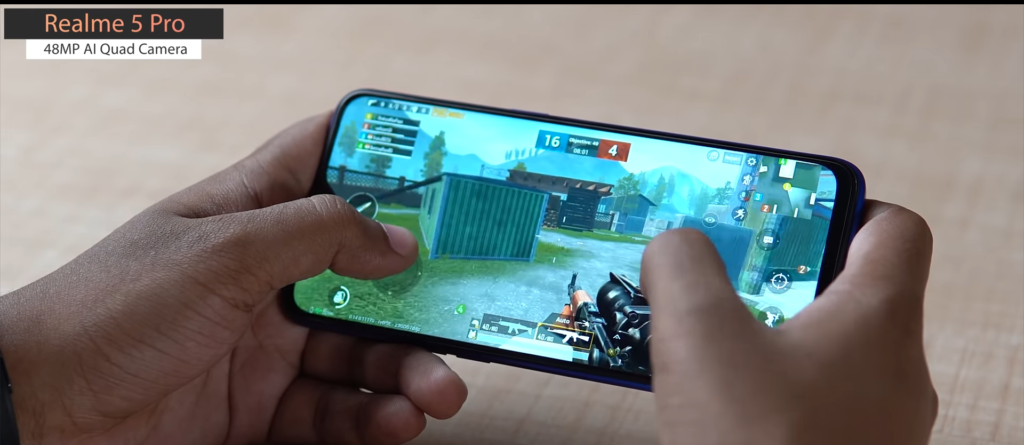
The Qualcomm 700 series chip will have some definite advantage over Mi A3 given hardcore gaming performance. But in terms of daily usage, both will pass with ease.
Mi A3 will come with 4GB of RAM, with storage options to choose from. Realme 5 Pro will also have multiple options to choose from with upto 8GB of RAM
In case of Mi A3, there’s two options to choose from, a base model with 64GB storage, and a higher-end model with 128 GB of storage. This time, you can add up to the overall storage. There’s an additional micro SD memory card slot to add up expandable storage. Again, there’s no extra space for a memory card, it’s a hybrid slot.
In terms of daily performance, Realme 5 Pro can run almost all tasks and mid-end games without any hiccups. There won’t be any noticeable difference in daily use given the memory-heavy apps and social media.
It does a great job when it comes to extended gaming and extensive multitasking. There are three models to choose from: 4GB RAM with 64GB storage, 6GB RAM with 64GB storage and 6GB RAM with 128GB storage.
Realme 5 Pro comes with a dedicated triple card slot that can support two nano SIM cards and a microSD card (up to 256GB of additional storage). Unlike Mi A3, you will get a dedicated slot for an additional micro SD memory card slot to add up expandable storage.
Software: Andrppoid One vs ColorOS
The biggest USP of Mi A3 is its seamless software. It’s an Android One smartphone running on Android 9.0 Pie with guaranteed Android Q upgrade.
Google will be offering guaranteed upgrades for the next two years since launch. Pure Android offers a clean operating system layer without any additional customizations.
Also, the Mi A3 has no ads, a big plus for any Xiaomi user.
The company hasn’t officially confirmed that Mi A3 won’t come with ads, but we didn’t have any ads on our unit. Even the other reviewers also haven’t yet found any ads on any Mi A3 unit in the country.
Realme 5 Pro will run on Android 9 Pie powered ColorOS. Realme is working on its own custom user interface, which will be made available to users by the end of this year. Loaded with customisations and tweaks, Mi A3 would obviously be a better choice with a clean UI onboard.
Cameras: 48MP Triple Camera vs 48MP Quad Camera, Who Got It Right?
Mi A3 comes with a three camera system featuring a 48-megapixel main Sony IMX 586 sensor with a focal length of f / 1.79, coupled, a secondary an 8-megapixel wide-angle sensor and finally a third 2-megapixel wide-angle lens. It’s the same 48MP sensor as Redmi Note 7 Pro with the depth sensor.
Here you get an additional wide-angle lens, which again is handy at times, but the 2MP sensor lacks details.
Realme 5 Pro will come with a quad-camera setup. Realme 5 Pro will also come with a 48MP primary sensor with f/1.8 aperture and 1.25 micron pixel size. The three additional sensors are going to be a wide-angle 8MP lens with a 119-degree field of view, a 2MP super macro lens and a dedicated 2MP depth sensor for portrait shots.
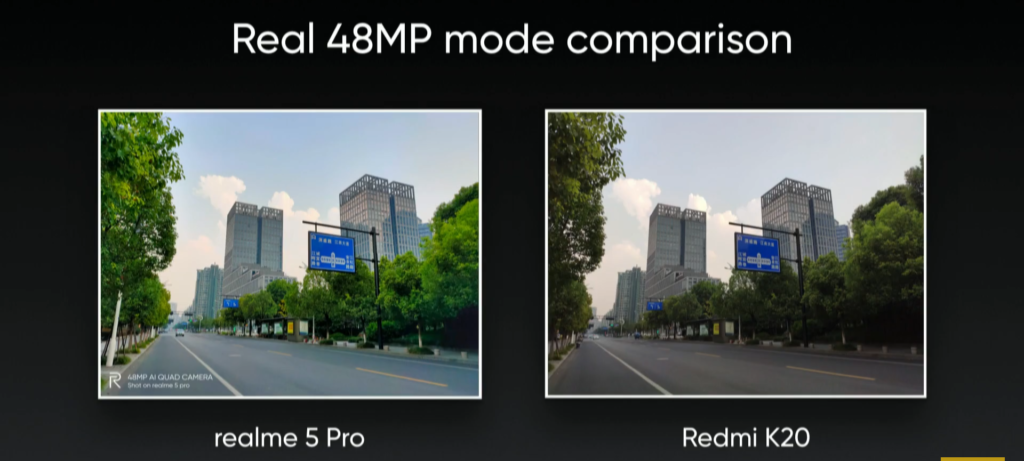
Inside the water drop notch, the company has used a 32-megapixel with an f / 2.0 aperture. Realme has the same front sensor as Realme X, the Sony IMX 471 16MP front sensor.
The smartphone does an awesome job when it comes to daylight photography. The photos in artificial lighting also did above average, and it can capture some cool portraits. The AI capability help the smartphone to join four pixels to form larger ones of 1.6 microns and offer a great low light performance.
The four camera setup has multiple sensors for multiple purposes.
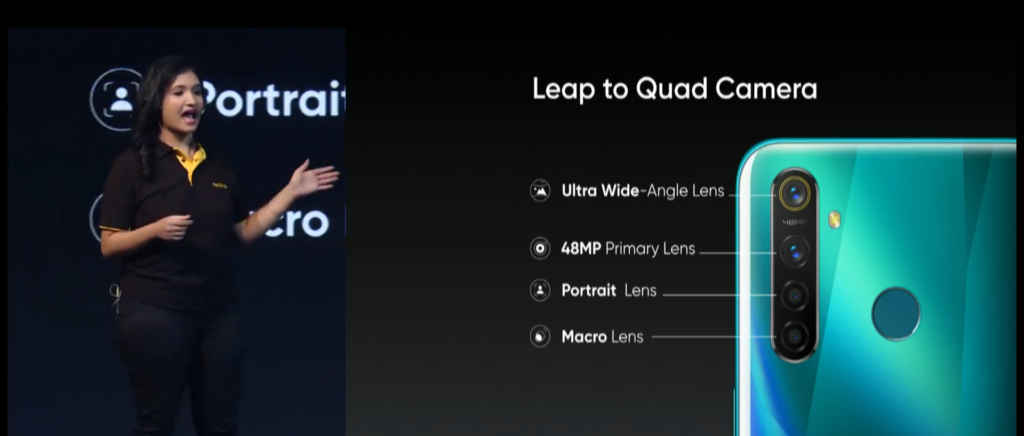
Both the rear and front camera on both the Realme 5 smartphones have EIS support, while the much-hyped Nightscape mode also has been improved.
Realme 5 Pro can take good detailed and sharp pictures in bright light with accurate colours. In poorly lit conditions, Realme 5 Pro manages to click decent photos with almost accurate details and colours. We are yet to test the camera in-depth, but the initial results are very impressive.
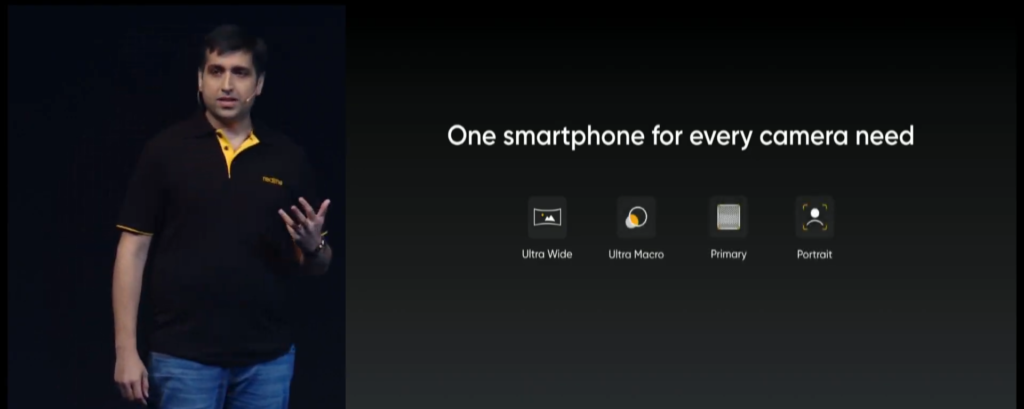
The dynamic range is good and it captures quite accurate details and produce good colours.
The HDR works fine, and the ultra-wide lens work fine. The macro lens and portrait sensor does their job decently.
The camera interface is quite minimal and it’s loaded with AI-powered modes to enhance the overall photography. AI works on both sides to adjust to the particular lighting and adjust the filters. In all, all thee three do good and make use of their respective lenses to take up some great shots.
Battery: VOOC 20W Charging vs QC 18W Charging
Unlike the previous two Mi A smartphone, finally the third Mi A device will come with a much bigger battery. Also, the previous generation A smartphones maintained the legacy of the new-age Type C ports, and Mi A3 carries the same. Mi A3 comes with a Type C USB connector supporting up to 18 watts fast charging. Inside the box you get the standard 10W charger, so you need to buy the fast charger separately.
Coming to the battery, it’s a large 4,000+ mAh unit, an upgrade over the 3,000mAh batteries from Mi A1 and Mi A2. The battery capacity has been increased to 4030 mAh, and it can easily run up to two days on a single charge on moderate usage.
The use of an HD+ has helped to increase the battery life, while the new Snapdragon 665 has made the device more efficient. Finally, with Android One on top, the smartphone will be able to perform well offering a good backup throughout.
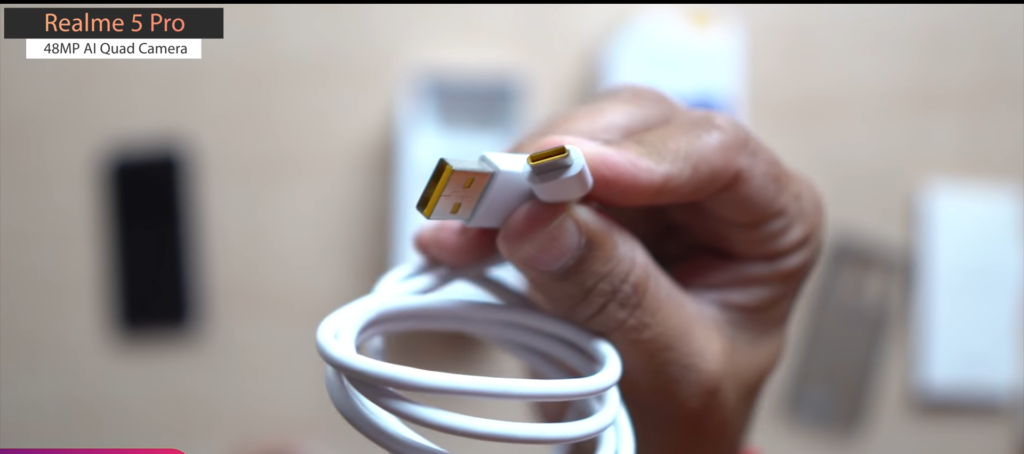
For the 5 Pro, there’s a big 4,035mAh battery. Compared to Realme 5, it’s slightly smaller, but the smartphone supports VOOC 3.0 fast charging with a Type C 20W fast charger included in the box. Realme 5 Pro can charge up the whole device under 80 minutes from 5 to 100 percent.
Coming to how it performs, the Realme 5 Pro can easily last more than a day on heavy usage, and even a day and a half on moderate use.
Pricing: Can Mi A3 Take On Realme 5 Pro?
The newly launched Xiaomi Mi A3 in Spain starts at €250 again, same as the previous Mi A2 price. If converted, that would be around INR 17,450. So the Mi A3 India price should be about the same as last year. But interestingly, Mi A2 wasn’t as successful as Mi A1 due to its overpriced models.
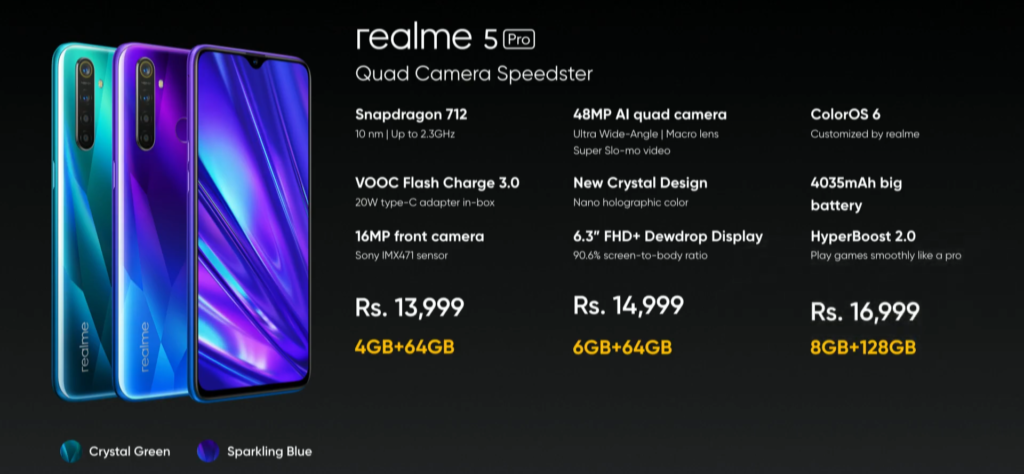
While Mi A1 had less competitors in 2017, the success of the predecessor pushed the makers to launch it at a higher price in 2018.
Even after being launched at a starting price of Rs 16,999, the smartphone is now selling at a starting price of as low as Rs 9,999. The company can’t go wrong again with the Mi A3 India pricing.
Already there is very tough competition in the segment, and a wrong choice of the price would throw Mi A3 out of the league. Realme’s new Realme 5 series is going to be a big threat. While Realme 5 will be powered by the same chip Mi A3, Realme 5 Pro has all it better to take on Mi A3 upfront.
Realme 5 Pro in India starts at Rs 13,999 for the base model with 4GB RAM and 64GB storage. There are two other models with 6GB RAM and 64GB, and a top model with 8GB RAM and 128GB storage priced at Rs 14,999 and Rs 16,999 respectively.
Realme 5 Pro will be available in two colour options: Crystal Green and Sparkling Blue colours via Flipkart and Realme.com from September 4, and offline later.
Most importantly, the company has used a HD+ only display on top with just a slightly improved processor. Anything over 11,000 or 12,000 rupees could turn out to be a big bummer for Mi A3 in India.

Comments are closed, but trackbacks and pingbacks are open.